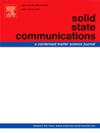Gd2CrFeO6陶瓷氧化物的结构、磁性和低温磁热性能
IF 2.1
4区 物理与天体物理
Q3 PHYSICS, CONDENSED MATTER
引用次数: 0
摘要
本文对各种含稀土陶瓷氧化物的磁热效应(MCE)进行了深入研究,试图获得适合低温磁冷却应用的磁性固体,并深入了解其固有的磁物理特性。本文测定了Gd2CrFeO6陶瓷氧化物的结构、磁性和低温磁热性能。我们的研究表明,Gd2CrFeO6陶瓷氧化物具有正交双钙钛矿型(b位无序)结构,并在约2.7 K处具有反铁磁跃迁。现有Gd2CrFeO6的组成元素在微米到纳米尺度上分布均匀,主要表现为Gd3+、Fe3+、Cr3+和O2−的价态。目前已经实现了Gd2CrFeO6的低温MCE。磁场变化为0 ~ 2/0 ~ 5 T时,Gd2CrFeO6陶瓷氧化物的最大磁熵变化和制冷剂容量分别达到10.33/34.34 J/kgK和55.85/239.96 J/kg。这些数值与大多数获得的具有卓越低温mce的含稀土材料相当,这使得Gd2CrFeO6陶瓷氧化物具有实际冷却应用的吸引力。本文章由计算机程序翻译,如有差异,请以英文原文为准。
Structural, magnetic and cryogenic magnetocaloric properties in Gd2CrFeO6 ceramic oxide
The magnetocaloric effect (MCE) in various rare earths (RE)-containing ceramic oxides were intensively investigated currently, attempted to acquire suitable magnetic solids for cryogenic magnetic cooling application and in-depth understand their inherent magneto-physical characters. We herein determined the structural, magnetic, and cryogenic magnetocaloric properties of Gd2CrFeO6 ceramic oxides. Our investigations indicate that the Gd2CrFeO6 ceramic oxide is crystallized with an orthorhombic double-perovskite type (B-site dis-ordered) structure and possesses an antiferromagnetic transition around ∼2.7 K. The constituent elementals in present Gd2CrFeO6 are uniformly distributed from micrometer to nanometer scales and mainly presented with the valence states of Gd3+, Fe3+, Cr3+, and O2−, respectively. Notable cryogenic MCE in present Gd2CrFeO6 has been realized. The maximum magnetic entropy changes and refrigerant capacity of Gd2CrFeO6 ceramic oxide with magnetic field variations of 0–2/0–5 T reach 10.33/34.34 J/kgK and 55.85/239.96 J/kg, respectively. These values are at comparable to most acquired rare earth-containing materials with remarkable cryogenic MCEs, making present Gd2CrFeO6 ceramic oxide attractive for practical cooling applications.
求助全文
通过发布文献求助,成功后即可免费获取论文全文。
去求助
来源期刊

Solid State Communications
物理-物理:凝聚态物理
CiteScore
3.40
自引率
4.80%
发文量
287
审稿时长
51 days
期刊介绍:
Solid State Communications is an international medium for the publication of short communications and original research articles on significant developments in condensed matter science, giving scientists immediate access to important, recently completed work. The journal publishes original experimental and theoretical research on the physical and chemical properties of solids and other condensed systems and also on their preparation. The submission of manuscripts reporting research on the basic physics of materials science and devices, as well as of state-of-the-art microstructures and nanostructures, is encouraged.
A coherent quantitative treatment emphasizing new physics is expected rather than a simple accumulation of experimental data. Consistent with these aims, the short communications should be kept concise and short, usually not longer than six printed pages. The number of figures and tables should also be kept to a minimum. Solid State Communications now also welcomes original research articles without length restrictions.
The Fast-Track section of Solid State Communications is the venue for very rapid publication of short communications on significant developments in condensed matter science. The goal is to offer the broad condensed matter community quick and immediate access to publish recently completed papers in research areas that are rapidly evolving and in which there are developments with great potential impact.
 求助内容:
求助内容: 应助结果提醒方式:
应助结果提醒方式:


